Carolyn’s Shade Gardens is a retail nursery located in Bryn Mawr, PA, specializing in showy, colorful, and unusual plants for shade. The only plants that we ship are snowdrops and miniature hostas. For catalogues and announcements of events, please send your full name, location, and phone number (for back up use only) to carolyn@carolynsshadegardens.com. Click here to get to the home page of our website for catalogues and information about our nursery and to subscribe to our blog.
 Indian pink, Spigelia marilandica, is one of the highlights of my garden in June. I would like to have a field of this wonderful, hummingbird-attracting native.
Indian pink, Spigelia marilandica, is one of the highlights of my garden in June. I would like to have a field of this wonderful, hummingbird-attracting native.
.
My post Pleasurable Pairings for Spring profiles plant combinations in my garden in April 2011. To read it, click here. I am continuing this theme with two posts on pleasing plant pairs for early summer. My house is on a south-facing slope, and the first post showed the gardens on the west side of the house. To read it, click here. Combinations from the east side of the house are in this post.
.
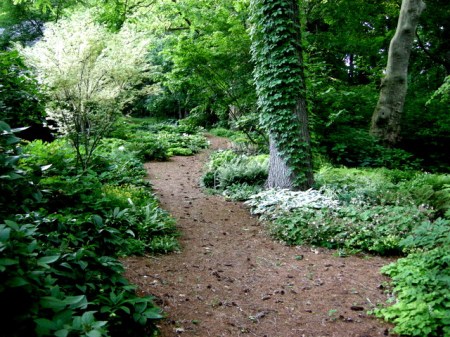 The view up the slope on the east side of the house. All the grass has been removed and replaced by garden beds and pine needle paths.
The view up the slope on the east side of the house. All the grass has been removed and replaced by garden beds and pine needle paths.
The gardens on the east side are fairly colorful when all the hellebores, snowdrops, primroses, pulmonarias, and other early perennials are blooming. However, by late spring, they become a much more subtle tapestry composed mainly of the leaves of hostas, epimediums, hellebores, and ferns. I love it, but it is more difficult to capture in photos than the colorful flowers on the west side. I wish you could all see it in person, but here is my best shot.
.
.
 Looking into the woods through the upper entrance with ‘Jimmy Crack Corn’ hosta on the left.
Looking into the woods through the upper entrance with ‘Jimmy Crack Corn’ hosta on the left.
.
 Ivory and blue ‘El Nino’ hosta really brightens up the shade, here with white bigleaf hardy geranium.
Ivory and blue ‘El Nino’ hosta really brightens up the shade, here with white bigleaf hardy geranium.
.
 More plants in my silver and blue garden, clockwise from upper left: hellebores, ‘Topaz’ hosta, native ‘Green Spice’ coralbells, and ‘Dawson’s White’ brunnera.
More plants in my silver and blue garden, clockwise from upper left: hellebores, ‘Topaz’ hosta, native ‘Green Spice’ coralbells, and ‘Dawson’s White’ brunnera.
.
 ‘Krossa Regal’ hosta’s frosty blue leaves and vase-shaped habit set it apart from other hostas.
‘Krossa Regal’ hosta’s frosty blue leaves and vase-shaped habit set it apart from other hostas.
.
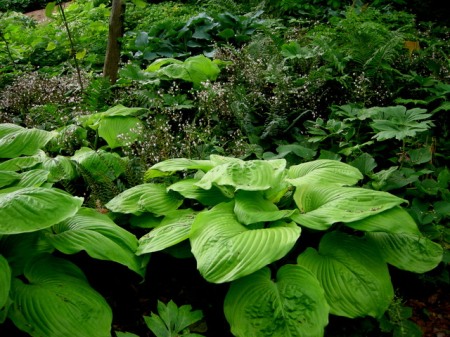 ‘Sum and Substance’ hosta in the woodland with mayapples and golden groundsel.
‘Sum and Substance’ hosta in the woodland with mayapples and golden groundsel.
.
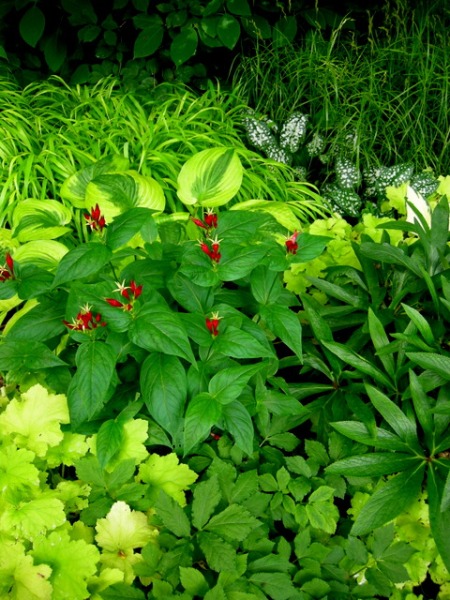 This shows how I use the native Indian pink featured at the start of the post. Clockwise from upper left: ‘All Gold’ Japanese hakone grass, ‘Little Blue’ pulmonaria, native sedge, hellebores, Hylomecon japonicum (no common name), ‘Citronelle’ coralbells, Indian pink, and ‘Summer Lovin’ hosta.
This shows how I use the native Indian pink featured at the start of the post. Clockwise from upper left: ‘All Gold’ Japanese hakone grass, ‘Little Blue’ pulmonaria, native sedge, hellebores, Hylomecon japonicum (no common name), ‘Citronelle’ coralbells, Indian pink, and ‘Summer Lovin’ hosta.
.
 ‘Summer Lovin’ hosta and ‘All Gold’ Japanese hakone grass make a great pair.
‘Summer Lovin’ hosta and ‘All Gold’ Japanese hakone grass make a great pair.
.
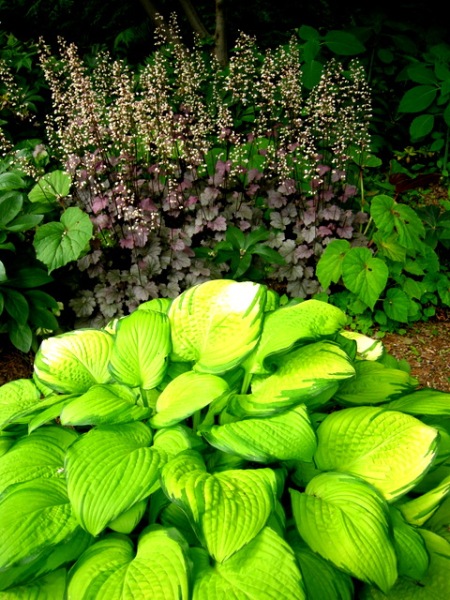 Hosta ‘Eye Declare’ and ‘Stainless Steel’ coralbells, one of the brighter combinations on the east side of the house at this time of year.
Hosta ‘Eye Declare’ and ‘Stainless Steel’ coralbells, one of the brighter combinations on the east side of the house at this time of year.
.
 Ferny-leafed dwarf goatsbeard with ‘June’ hosta
Ferny-leafed dwarf goatsbeard with ‘June’ hosta
.
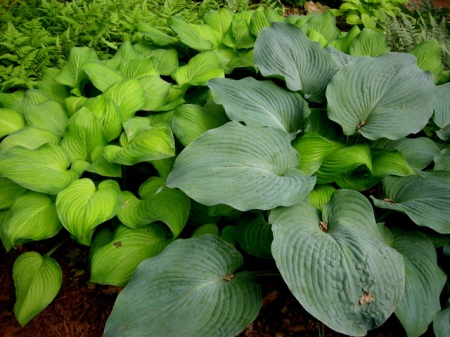 Customers often ask me which hostas go together, and my answer is they all do: ‘Guacamole’ and ‘Blue Angel’.
Customers often ask me which hostas go together, and my answer is they all do: ‘Guacamole’ and ‘Blue Angel’.
.
 Looking down the hill over my newest installation, a miniature hosta rock garden. I needed a dedicated area to display my collection.
Looking down the hill over my newest installation, a miniature hosta rock garden. I needed a dedicated area to display my collection.
.
 A view of the miniature hosta rock garden from below.
A view of the miniature hosta rock garden from below.
.
 Dwarf lady fern, ‘Teaspoon’ hosta, and ‘Remember Me’ hosta on the right.
Dwarf lady fern, ‘Teaspoon’ hosta, and ‘Remember Me’ hosta on the right.
.
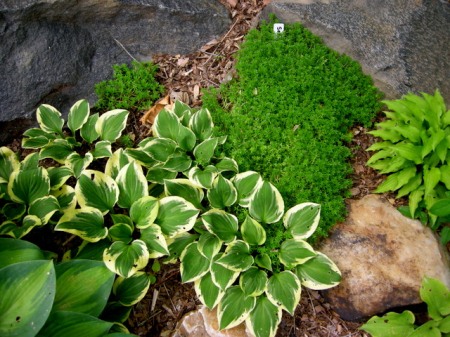 ‘Pixie Vamp’ hosta with Sedum lydium and ‘Rock Prince’ hosta.
‘Pixie Vamp’ hosta with Sedum lydium and ‘Rock Prince’ hosta.
.
 ‘Blonde Elf’ hosta, dwarf lady fern, and ‘Blue Mouse Ears’ hosta
‘Blonde Elf’ hosta, dwarf lady fern, and ‘Blue Mouse Ears’ hosta
.
I hope you enjoyed Part 2.
Carolyn
.
Carolyn’s Shade Gardens is a retail nursery located in Bryn Mawr, Pennsylvania, U.S., zone 6b. The only plants that we mail order are snowdrops and miniature hostas and only within the US.
If you are within visiting distance and would like to receive catalogues and information about customer events, please send your full name and phone number to carolynsshadegardens@verizon.net. Subscribing to my blog does not sign you up to receive this information.
Nursery Happenings: The nursery closes for the summer on June 15 and will reopen in the fall around September 15. Have a great summer.
Facebook: Carolyn’s Shade Gardens has a Facebook Page where I post single photos, garden tips, and other information that doesn’t fit into a blog post. You can look at my Facebook page here or click the Like button on my right sidebar here.
Notes: Every word that appears in orange on my blog is a link that you can click for more information. If you want to return to my blog’s homepage to access the sidebar information (catalogues, previous articles, etc.) or to subscribe to my blog, just click here.





 Talk about perfect, Hosta ‘Paradise Joyce’.
Talk about perfect, Hosta ‘Paradise Joyce’.










 Hosta ‘Blue Mouse Ears’ is the 2008 Hosta of the Year.
Hosta ‘Blue Mouse Ears’ is the 2008 Hosta of the Year.





